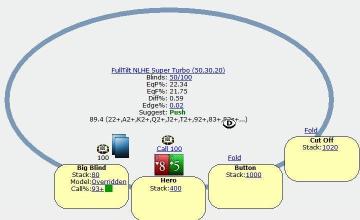The "Limp and Go"
Another Tactic to Induce Folds
The Limp and Go:
In the book "Winning Poker Tournaments One Hand at a Time: Volume I" (a book on Multi-table tournament play), PearlJammer talked about a play he calls the "limp and go".
This play is a lot like the "stop and go" play where you just call a preflop raise out-of-position with very short effective stacks with a hand like 55 planning to shove (or bet) any flop in hopes of getting the other player to fold some of his hands that actually have odds to call you.
It requires you to be first in from the small blind and either you or the big blind are extremely short stacked.
Instead of raising all-in, knowing the big blind has to call with any two cards, you just call. Sometimes he'll shove all-in (ruining your plan but with no penalty to you) and you'll always call. But if he checks behind your preflop limp, then you bet any flop (unless you flop a monster). If he completely misses the flop, he'll sometimes fold even getting huge odds and sometimes with the better hand.
For example, it's 4-handed and you are in the small blind with 85-offsuit. The big blind starts the hand with only 1.8 BBs.
CLICK IMAGE TO SEE LARGER VERSION (opens in new window)

So you have a profitable shove when it's folded to you almost no matter what your hand is. But if you shove, he'll always call for his last 0.8 BBs getting 3.5-to-1 odds. You'd actually prefer him to fold any hand in this spot, even hands you dominate like 52-offsuit. So with him getting
3.5-to-1 you can't induce a fold preflop, however ...
If you limp preflop, he checks, then you bet the flop, he just might fold. For example, if the flop is K94 he might fold a hand like 73 or even something thats ahead of you like J3 or T7.
The "limp and go" is a good play up to effective stacks of around 2.5 BBs. With stacks from 2.5 to about 3.5 BBs, I prefer minraising to try to induce him to fold preflop. With stacks below 2.5 BBs, you just can't induce preflop folds.
Just like the "stop and go", the key to the "limp and go" is being first to act on the flop, therefore it won't work when you're down to the last two (heads up), because the small blind is the button, so if you open limp, the other guy can actually "check and go" you!
The "limp and go" works surprisingly often especially on the bubble when players are desperate to survive. There is no real downside to the play. You know YOU are never folding at any point no matter what. You are just giving him a chance to fold on the flop.
If you hit the flop, you should still almost always bet, because I've found that players won't bluff the flop with something they would have folded had you bet out, because they know a bluff won't work (and they are right). If you happen to flop a huge hand like trips or a straight, you can check the flop and hope that he hits a pair or draw on the turn and puts his money in the then.
When you miss the flop, don't just quickly minbet him all-in as if that was your plan the whole way. Wait about a second then bet about 3/4 of the pot even though that bet is still several times as big as his remaining stack. Make it seem like you don't even realize how short he is. Mimic how a player might bet a real hand in a normal situation.
If you hit top pair, you can quickly minbet him all-in as if that was your plan the whole way. This might make you look weak. You're reversing the "strong means weak" timing tell.
This variation of the "stop and go" poker tactic is just one more trick to help you induce your opponent to fold.
return from "limp and go" to Inducing Folds
see also: Inducing Calls